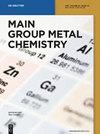On computation of neighbourhood degree sum-based topological indices for zinc-based metal–organic frameworks
IF 1.2
3区 化学
Q3 CHEMISTRY, INORGANIC & NUCLEAR
引用次数: 1
Abstract
Abstract The permeable materials known as metal–organic frameworks (MOFs) have a large porosity volume, excellent chemical stability, and a unique structure that results from the potent interactions between metal ions and organic ligands. Work on the synthesis, architectures, and properties of various MOFs reveals their utility in a variety of applications, including energy storage devices with suitable electrode materials, gas storage, heterogeneous catalysis, and chemical assessment. A topological index, which is a numerical invariant, predicts the physicochemical properties of chemical entities based on the underlying molecular graph or framework. In this article, we consider two different zinc-based MOFs, namely zinc oxide and zinc silicate MOFs. We compute 14 neighbourhood degree sum-based topological indices for these frameworks, and the numerical and graphical representations of all the aforementioned 14 indices are made.锌基金属-有机框架基于邻域度和的拓扑指数计算
摘要被称为金属-有机框架(MOFs)的可渗透材料具有大的孔隙率、优异的化学稳定性和独特的结构,这是金属离子和有机配体之间强有力的相互作用的结果。对各种MOFs的合成、结构和性能的研究揭示了它们在各种应用中的效用,包括具有合适电极材料的储能装置、气体储存、多相催化和化学评估。拓扑指数是一种数值不变量,它基于底层分子图或框架来预测化学实体的物理化学性质。在本文中,我们考虑了两种不同的锌基MOFs,即氧化锌和硅酸锌MOFs。我们为这些框架计算了14个基于邻域度和的拓扑指数,并对上述14个指数进行了数值和图形表示。
本文章由计算机程序翻译,如有差异,请以英文原文为准。
求助全文
约1分钟内获得全文
求助全文
来源期刊

Main Group Metal Chemistry
CHEMISTRY, INORGANIC & NUCLEAR-CHEMISTRY, ORGANIC
CiteScore
4.10
自引率
27.80%
发文量
21
审稿时长
4 weeks
期刊介绍:
This journal is committed to the publication of short communications, original research, and review articles within the field of main group metal and semi-metal chemistry, Main Group Metal Chemistry is an open-access, peer-reviewed journal that publishes in ongoing way. Papers addressing the theoretical, spectroscopic, mechanistic and synthetic aspects of inorganic, coordination and organometallic main group metal and semi-metal compounds, including zinc, cadmium and mercury are welcome. The journal also publishes studies relating to environmental aspects of these metals, their toxicology, release pathways and fate. Articles on the applications of main group metal chemistry, including in the fields of polymer chemistry, agriculture, electronics and catalysis, are also accepted.
 求助内容:
求助内容: 应助结果提醒方式:
应助结果提醒方式:


